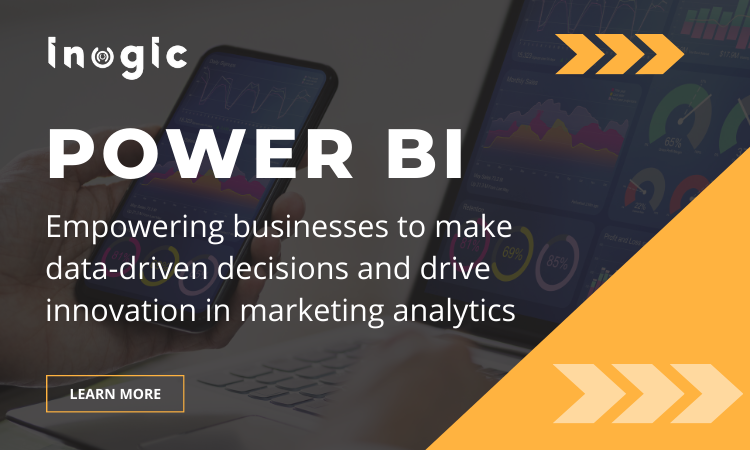Data and Analytics (D&A) are widely recognized as the next frontier for driving innovation and enhancing productivity in the business realm. According to a report by McKinsey, organizations that embrace data-driven approaches can achieve impressive increases in EBITDA, with potential gains of up to 25%. Moreover, the majority of the world’s top 10 innovative companies, as identified by Boston Consulting, are data-focused enterprises emphasizing the crucial role of data in shaping competitive advantages within the market.
To effectively leverage data and gain a competitive edge, organizations require powerful tools that enable marketers to make informed, data-driven decisions. One such tool that has made its mark with marketing analytics is Power BI. This blog will venture into the key features and benefits of Power BI for marketing analytics and explore how it empowers businesses to make data-driven decisions.
Power BI and Marketing Analytics
Power BI, developed by Microsoft, is a user-friendly analytics tool that connects businesses to data sources, transforming raw data into valuable insights and appealing reports. It facilitates marketing analytics with data integration, diverse visualizations, real-time reporting, and advanced analytics like predictive analytics and machine learning. Marketers can make informed decisions, identify trends, monitor campaigns, and optimize strategies efficiently.
Leveraging Power BI for Marketing Analytics
1. Data Preparation and Integration
Before diving into marketing analytics using Power BI, it is essential to ensure that your data is well-prepared and properly integrated. Follow these steps to leverage Power BI effectively:
- Identify Key Data Sources: Determine the primary data sources relevant to your marketing analytics, such as CRM systems, Google Analytics, social media platforms, and advertising platforms.
- Data Cleaning and Transformation: Cleanse and transform your data to ensure consistency and accuracy. Remove duplicates, handle missing values, and standardize data formats.
- Data Integration: Connect Power BI to your data sources and import the relevant datasets. It offers a wide range of connectors that allow seamless integration with various data sources.
- Data Modeling: Create a data model that aligns with your marketing goals. Define relationships between tables, create calculated columns and measures, and optimize data for efficient analysis.
2. Visualizing Marketing Data
Once your data is prepared and integrated, you can start visualizing your marketing data using Power BI. Follow these best practices for effective data visualization:
- Right Visualizations: Select appropriate visualizations based on the type of data you want to represent. Get a variety of visualizations, including bar charts, line charts, pie charts, maps, and more with Power BI.
- Key Metrics: Identify the key metrics and KPIs (Key Performance Indicators) relevant to your marketing goals. Highlight these metrics prominently in your reports and dashboards for easy tracking.
- Filters and Slicers: Implement filters and slicers to enable interactive exploration of your data. Users can drill down into specific dimensions or filter data based on specific criteria, enhancing data analysis capabilities.
- Interactive Dashboards: Build interactive dashboards that provide an overview of your marketing performance. Arrange visualizations logically and use drill-through features to enable deeper analysis.
3. Advanced Analytics and Insights
Power BI offers advanced analytics capabilities that can take your marketing analytics to the next level. Here are some ways to leverage advanced analytics in Power BI:
- Predictive Analytics: Forecast future outcomes like customer churn, lifetime value, and conversion rates using predictive analytics algorithms. Optimize marketing strategies based on these insights.
- Segmentation and Targeting: Effectively segment your customer base using machine learning algorithms. Tailor marketing campaigns based on demographic, behavioral, or transactional attributes.
- Text Analytics: Extract valuable insights from unstructured text data such as social media comments and customer reviews. Analyze sentiment, identify trends, and gauge customer satisfaction using Power BI’s text analytics features.
- Marketing Attribution: Measure the impact of marketing activities across channels and touchpoints. Use Power BI to attribute conversions and analyze campaign effectiveness.
Fostering a culture centered around data empowers organizations to enhance their effectiveness and efficiency. As per Forrester, organizations that leverage data to extract valuable insights for decision-making are nearly three times as likely to achieve double-digit growth.
Power BI empowers marketers with robust analytics and visualization capabilities, enabling data-driven decision-making in the realm of marketing analytics. By leveraging Power BI’s data integration, visualization, and advanced analytics features, marketers can gain valuable insights, optimize marketing campaigns, and drive business growth. Stay ahead of the competition by harnessing the power of Power BI for marketing analytics and making data-driven decisions that propel your business to success.
In conclusion, Power BI is a robust tool for marketing analytics that empowers businesses to make data-driven decisions. By integrating and visualizing data from various sources, marketers can gain a comprehensive view of their efforts. With real-time reporting, advanced analytics, and actionable insights, Power BI enables marketers to optimize campaigns and target segments effectively. By leveraging Power BI for marketing analytics, organizations can foster a culture centered around data and achieve significant growth through informed decision-making.
Inogic is a renowned Microsoft Gold ISV Partner, specializing in Dynamics 365 CRM and Power Platform professional services in India. With over 15 innovative apps, we bridge functional gaps, enhance user adoption, and boost productivity within Microsoft Dynamics 365 CRM. Our applications streamline business processes, ensuring a high return on investment. In addition to our app offerings, Inogic offers top-notch offshore development services for Dynamics CRM and Power Platform, delivering high-quality solutions at competitive prices.
When it comes to Power BI for marketing analytics, Inogic as an Offshore Techno-functional consultant excels at maximizing its potential. Our Power Platform development services enable businesses to integrate data from multiple sources, effectively visualize insights, access real-time reporting, and leverage advanced analytics. This partnership empowers organizations to make data-driven decisions and gain a competitive edge.
We also contribute to the community through our popular Inogic Blogs, which provide regular high-quality tips and tricks on all things Dynamics 365 CRM and Power Platform. To learn more about how Inogic can enhance your user experience with Dynamics 365 CRM and Power Platform, visit our website, or contact us at crm@inogic.com.
